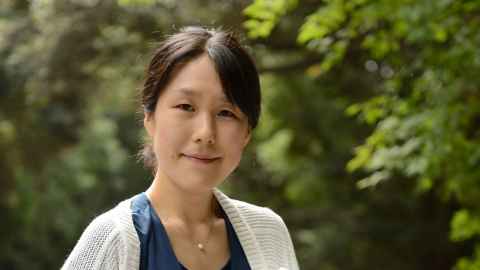Take 10 with... Tomoko Aoyama
Dr Tomoko Aoyama explains her research into the determinants of physical inactivity in children, and how and when to intervene.

1. Describe your research topic to us in 10 words or less.
Early intervention to promote physical activity across the lifespan
2. Now describe it in everyday terms!
Physical inactivity is carried over from childhood into adulthood, which increases the risk of non-communicable disease in later life. My research into early-life determinants of childhood physical inactivity is trying to find a way to promote health across the lifespan.
3. What are some of the day-to-day research activities you carry out?
I do developmental assessments of children participating in follow-up and intervention studies at the Clinical Research Unit. Sometimes I visit the participant’s home to follow-up. In particular, I am trying to measure infant muscle strength (handgrip) using a newly designed small dynamometer. I also attend meetings and write grant applications, ethics applications, research papers and so on.
4. What do you enjoy most about your research?
I enjoy meeting lots of children at their assessments. This allows me to see the diversity of child development. In a past study I did in Japan, I had a chance to assess the same children a few years later. I was impressed with how they were growing up and happy to know some of them remembered me.
5. Tell us something that has surprised or amused you in the course of your research.
In the early stages of my research I focused on birth weight because much of the literature showed an association between lower birth weight and later adverse outcomes. However, our study showed that later gross motor development in infancy, rather than lower birth weight, was more strongly related to physical inactivity at school ages. Also, later gross motor development is predictive of increased body fat mass at school ages. This inspired me to think that the postnatal period may be more critical in determining future health. It was the turning point that led to my current research into the determinants of gross motor development.
6. How have you approached any challenges you’ve faced in your research?
When I first worked on the research into physical activity and reviewed the past literature, I noticed something that didn’t make sense. Animal studies showed that offspring born from undernourished mothers were less active. This formed a theory that "undernutrition before/during pregnancy causes future physical inactivity in offspring". Scientists then began working on human studies to establish this theory, and epidemiological studies to examine birth weight and physical activity during childhood were conducted in different cohorts. However, they failed to show any objective evidence.
I wondered if there had been methodological issues in measuring physical activity accurately. As children’s behaviour consists of complex movements and is quite different from adults, identifying the individual differences in physical activity among these ages with high accuracy is challenging. This led me to a laboratory developing accelerometers which evaluate children's physical activity with high accuracy, where I got an opportunity to clarify the relationship between early-life factors and physical activity during childhood.
7. What questions have emerged as a result?
The results showed us the importance of infant motor development, not birth weight, in determining health (physical activity and obesity) during childhood. This prompted me to ask why the individual differences in gross motor development are seen? For instance, some children walk independently at nine months and some at two years, even though they are healthy. So the next question is, what determines differences in gross motor development in infancy?
8. What impact is your research having or what impact do you hope it will have?
I am currently trying to examine the effects of nutrition after birth and muscle strength at two years of age in moderate-to late-preterm babies. This trial might tell us why some children walk early and others later in terms of muscular development. I hope it will help us understand individual differences in gross motor development. It may also lead to early nutritional interventions that optimise motor development.
9. If you collaborate across the University, or outside the University, who do you work with and how does it benefit your research?
I am a visiting research fellow at the Liggins Institute funded by the Japanese Society for the Promotion of Science. I mainly collaborate with my supervisor, Professor Flank Bloomfield, the director of the Institute. I also work with Dr Jacquie Bay who focuses on knowledge translation, mixed methods and qualitative research. I collaborate with Dr Silmara Gusso at the Department of Exercise Sciences in the University's Faculty of Science, who gave me the opportunity to join an exercise intervention study for children with cerebral palsy. And I work with Dr Hidemi Takimoto at the National Institute of Health and Nutrition in Japan, who has expertise in nutritional epidemiology. We are about to work on a study on thinness in young Japanese women using the Japanese National Health and Nutrition Survey data.
10. What one piece of advice would you give your younger, less experienced research self?
You don't need to be perfect. You can collaborate with someone who has what you don't have.